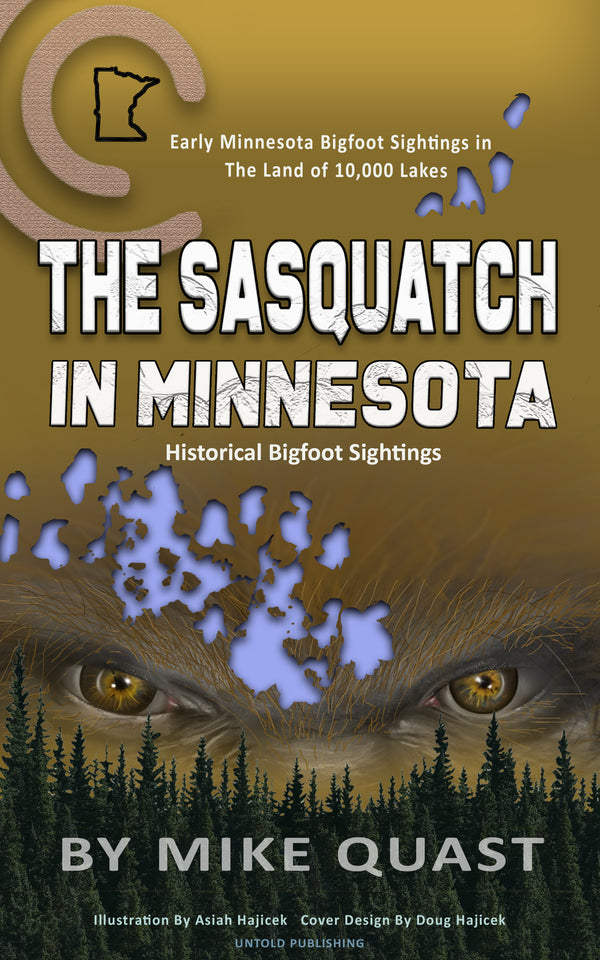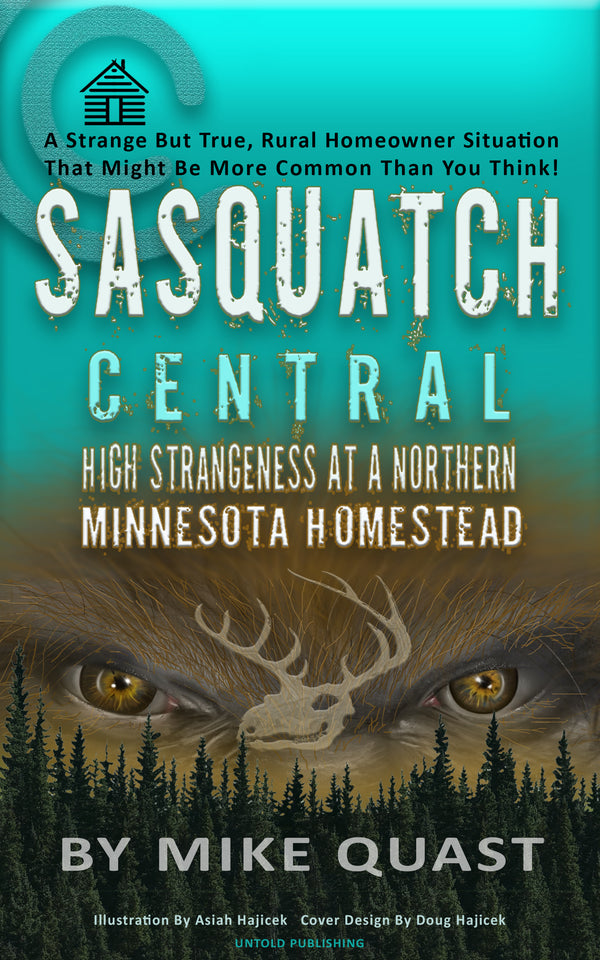Exploring Bigfoot Conservation Efforts for a Sustainable Future

By Anthony Romano, Cryptozoologist
In the dense, misty forests of the Pacific Northwest, a legend persists that captures the imagination of millions: Bigfoot. This elusive creature, also known as Sasquatch, has become more than just a mythical beast lurking in the shadows of our collective consciousness. It has evolved into a powerful symbol of wilderness preservation and a catalyst for environmental conservation efforts.
The allure of Bigfoot extends far beyond its role in campfire stories and blurry photographs. It represents our fascination with the unknown, our connection to the natural world, and increasingly, our responsibility to protect the habitats where this creature is said to roam. As we face unprecedented environmental challenges, the legend of Bigfoot offers a unique lens through which we can examine and promote conservation efforts.
The Origins of Bigfoot
The story of Bigfoot is deeply rooted in North American folklore, particularly among Indigenous communities. Long before European settlers arrived, Native American tribes shared tales of giant, hair-covered beings that walked on two legs. The Lummi people of the Pacific Northwest, for instance, speak of the "Ts'emekwes," while the Lakota Sioux have stories of the "Chiye-tanka" or "Big Elder Brother." These narratives often portrayed these creatures as guardians of the forest or spirits of nature, emphasizing the deep connection between the land and its inhabitants.
As European exploration and settlement expanded across North America, these Indigenous stories began to blend with frontier tales of wild men and mysterious creatures. The modern concept of Bigfoot as we know it today began to take shape in the mid-20th century, particularly after a series of highly publicized sightings and the famous Patterson-Gimlin film of 1967, which purportedly shows a female Bigfoot walking along a creek bed in northern California.
Characteristics and Habitat
Descriptions of Bigfoot typically portray a large, bipedal creature standing between 6 to 10 feet tall, covered in dark hair, with a pronounced brow ridge and a distinctly human-like gait. Sightings often occur in remote, heavily forested areas, with the Pacific Northwest being a particular hotspot. States like Washington, Oregon, and northern California have become synonymous with Bigfoot lore, their vast wilderness areas providing the perfect backdrop for tales of an undiscovered primate.
Ecological Importance of Bigfoot Habitats
The habitats associated with Bigfoot sightings are not just the stuff of legend; they represent some of the most ecologically important and biodiverse regions in North America. The old-growth forests of the Pacific Northwest, for example, are home to a staggering array of plant and animal species, many of which are found nowhere else on Earth. These ecosystems play a crucial role in maintaining ecological balance, from supporting endangered species to regulating climate and water cycles.
Climate Regulation and Water Cycle
Consider the impact of these forests on climate regulation. The towering trees that dominate these landscapes act as massive carbon sinks, absorbing and storing vast amounts of carbon dioxide from the atmosphere. A single old-growth tree can sequester hundreds of tons of carbon over its lifetime, making these forests invaluable in the fight against climate change. The dense canopy and rich understory of these forests also play a vital role in the water cycle, filtering rainwater, preventing soil erosion, and maintaining the health of rivers and streams that are critical for both wildlife and human communities.
Biodiversity and Ecosystem Health
The ecological importance of these areas extends far beyond their role in climate and water regulation. They serve as crucial habitats for numerous endangered species, from the northern spotted owl to various salmon species that rely on clean, cold streams for spawning. The complex web of life in these forests includes countless interdependent species, from the smallest soil microbes to apex predators like wolves and mountain lions. In this context, the legend of Bigfoot serves as a powerful metaphor for the unknown and undiscovered aspects of these ecosystems, reminding us that there is still much to learn and protect in our natural world.
Bigfoot Research Organizations and Conservation
As public interest in Bigfoot has grown, so too have efforts to study and protect the creature's alleged habitat. Organizations like the Bigfoot Field Researchers Organization (BFRO) and the North American Wood Ape Conservancy (NAWAC) have emerged, dedicated to investigating Bigfoot sightings and promoting conservation of the areas where these sightings occur. While their primary focus may be on finding evidence of Bigfoot, these groups often contribute valuable data on local ecosystems and wildlife populations.
The BFRO, for instance, maintains an extensive database of Bigfoot sightings and conducts regular expeditions into areas of reported activity. These expeditions not only search for signs of the elusive creature but also document local flora and fauna, contributing to our understanding of these often under-studied ecosystems. Similarly, NAWAC's long-term research projects in areas like the Ouachita Mountains of Oklahoma and Arkansas have provided valuable insights into the biodiversity and ecological health of these regions.
Public Awareness and Education
Public awareness campaigns leveraging Bigfoot's cultural significance have proven to be effective tools for promoting conservation. Documentaries, educational programs, and even local festivals centered around the Bigfoot legend often incorporate strong environmental messages. These initiatives serve a dual purpose: they satisfy public curiosity about the mysterious creature while also educating people about the importance of preserving wild spaces.
For example, the annual Bigfoot Daze festival in Willow Creek, California – a town that bills itself as the "Bigfoot Capital of the World" – not only celebrates the local legend but also promotes environmental stewardship. Attendees learn about local ecosystems, sustainable practices, and the importance of preserving the region's natural heritage. Such events demonstrate how the cultural appeal of Bigfoot can be harnessed to foster a deeper connection between people and their environment.
Indigenous Collaboration and Traditional Knowledge
Collaborations with Indigenous communities have become an increasingly important aspect of Bigfoot-related conservation efforts. Many Native American tribes have long-standing traditions and stories related to Bigfoot-like creatures, often emphasizing themes of respect for nature and the interconnectedness of all living things. By incorporating traditional ecological knowledge into conservation strategies, researchers and environmentalists can develop more holistic and culturally sensitive approaches to habitat preservation.
The Hoopa Valley Tribe in northern California, for instance, has worked with researchers to document traditional stories about Bigfoot-like creatures and to identify areas of cultural and ecological significance. This collaboration not only helps preserve Indigenous cultural heritage but also contributes to more effective conservation strategies that take into account the complex relationships between human communities and their natural environment.
Legal and Ethical Considerations
Legal Landscape
The legal landscape surrounding Bigfoot and its habitat protection is as varied and complex as the creature's legend itself. In 1969, Skamania County in Washington State passed an ordinance making it illegal to kill Bigfoot, with penalties including a hefty fine and potential imprisonment. This law, while initially seen as a publicity stunt, has since been amended to classify Bigfoot as an endangered species within the county. While the ordinance may seem whimsical, it reflects a genuine concern for protecting local wildlife and habitats.
Other states have taken different approaches. In Texas, for example, the Parks and Wildlife Department has stated that there are no regulations protecting Bigfoot, effectively making it legal to hunt the creature if it were to exist. This stance has sparked debates about the ethical implications of hunting a being that may or may not exist and the potential impact on local ecosystems.
These varying legal approaches highlight the complex interplay between myth, public sentiment, and conservation policy. While laws specifically protecting Bigfoot may be rare, they often serve as a proxy for broader habitat protection measures. By designating certain areas as Bigfoot habitats, local governments can effectively create protected zones that benefit a wide range of species and ecosystems.
Ethical Considerations
The ethical considerations surrounding Bigfoot conservation extend beyond legal frameworks. They touch on fundamental questions about our responsibility to protect all creatures, known and unknown, and the value we place on undisturbed wilderness. The very idea of Bigfoot challenges us to consider the possibility of undiscovered species and the importance of preserving habitats that may harbor unknown forms of life.
This ethical dimension of Bigfoot conservation aligns closely with broader environmental ethics and the concept of biocentric preservation – the idea that nature has intrinsic value beyond its utility to humans. By advocating for the protection of Bigfoot's habitat, conservationists are essentially arguing for the preservation of wilderness for its own sake, not just for human benefit.
Technological Innovations in Bigfoot Research and Conservation
The search for Bigfoot has also spurred technological innovations in wildlife research and habitat monitoring. Advanced technologies like thermal imaging cameras, environmental DNA analysis, and high-resolution satellite imagery are being employed in the quest to find evidence of the elusive creature. While these efforts may not have produced definitive proof of Bigfoot's existence, they have contributed valuable data and methodologies to the field of wildlife biology and conservation.
Satellite imagery, for instance, allows researchers to track changes in forest cover and identify potential Bigfoot habitats over vast areas. This technology has applications far beyond cryptozoology, enabling conservationists to monitor deforestation, track wildlife movements, and identify areas in need of protection. Similarly, the use of drones for aerial surveys and environmental DNA sampling techniques developed for Bigfoot research have found applications in studying endangered species and monitoring ecosystem health.
Data Analytics and Genetic Research
Data analytics plays a crucial role in modern Bigfoot research and related conservation efforts. By analyzing patterns in sighting reports, researchers can identify potential hotspots of activity and correlate these with environmental factors. This approach not only aids in the search for Bigfoot but also provides valuable insights into wildlife behavior and habitat preferences.
The North American Wood Ape Conservancy, for example, uses sophisticated data analysis techniques to study patterns in reported sightings and to guide their field research. Their work has contributed to a better understanding of the ecological characteristics of areas where Bigfoot sightings are common, highlighting the importance of preserving these habitats regardless of the creature's existence.
Genetic research, while yet to provide evidence of Bigfoot, has opened new avenues for studying biodiversity in alleged Bigfoot habitats. Environmental DNA sampling, which involves collecting genetic material from soil, water, or air samples, has the potential to reveal the presence of unknown species or populations. While these techniques have not uncovered Bigfoot DNA, they have led to discoveries of previously unknown species and populations of rare animals in remote areas.
Bigfoot as an Environmental Icon
The role of Bigfoot as an environmental icon extends beyond scientific research and legal protections. The creature has become a powerful symbol for wilderness preservation and a tool for engaging the public in conservation efforts. The mystery and allure of Bigfoot can draw people into discussions about habitat loss, species extinction, and the importance of preserving wild spaces.
Conservation organizations have recognized the potential of Bigfoot as a "flagship species" – a charismatic creature that can rally public support for broader environmental causes. Much like how pandas have become symbols for endangered species conservation or how whales represent marine protection efforts, Bigfoot can serve as an ambassador for North American wilderness preservation.
This symbolic role has tangible benefits for conservation efforts. Bigfoot-themed nature trails, educational programs, and eco-tourism initiatives can attract visitors to remote areas, bringing economic benefits to local communities and raising awareness about the importance of habitat preservation. For example, the Bigfoot Trail, a 360-mile hiking route through the Klamath Mountains of northern California, not only offers outdoor enthusiasts a chance to explore "Bigfoot country" but also highlights the region's unique biodiversity and the need for conservation.
Case Studies of Successful Conservation Initiatives
Case studies of successful conservation initiatives linked to Bigfoot demonstrate the potential of this approach. In the Siskiyou Mountains of Oregon, local conservationists have leveraged public interest in Bigfoot to advocate for the protection of old-growth forests. Their efforts have resulted in increased funding for habitat restoration projects and greater public engagement in local conservation issues.
Similarly, in British Columbia, Canada, the "Sasquatch Provincial Park" not only capitalizes on the region's Bigfoot lore but also protects important wildlife corridors and sensitive ecosystems. The park's popularity among Bigfoot enthusiasts has led to increased visitation and greater public support for conservation measures in the area.
Community Engagement and Citizen Science
Community engagement and public participation are crucial components of successful Bigfoot-related conservation efforts. Grassroots movements, often started by local Bigfoot enthusiasts, have played significant roles in shaping conservation policies and raising awareness about environmental issues in their communities.
Educational outreach programs that use Bigfoot as a hook to engage people in discussions about ecology and conservation have proven particularly effective. Schools, nature centers, and community organizations have developed curricula and programs that use the Bigfoot legend as a starting point for teaching about local ecosystems, wildlife biology, and the scientific method.
Citizen science initiatives have also emerged, encouraging the public to participate in Bigfoot research and related conservation efforts. Projects like the Bigfoot Sighting Report Database allow individuals to contribute their observations, creating a vast repository of data that researchers can analyze for patterns and trends. While the primary focus may be on Bigfoot sightings, these projects often collect valuable information about local wildlife, plant species, and environmental conditions.
The concept of "Bigfooting" – the act of searching for evidence of Bigfoot – has evolved into a form of eco-tourism that encourages people to explore and appreciate natural areas. Many Bigfoot enthusiasts approach their searches with a strong conservation ethic, adhering to "leave no trace" principles and advocating for the protection of the habitats they explore.
Conclusion: The Future of Bigfoot Conservation
As we continue to grapple with pressing environmental challenges, from climate change to biodiversity loss, the legend of Bigfoot offers a unique perspective on our relationship with the natural world. It reminds us of the wonder and mystery that still exists in our forests and mountains, and the importance of preserving these wild spaces not just for their ecological value, but for their cultural and spiritual significance as well.
The search for Bigfoot, whether driven by scientific curiosity, cultural tradition, or simple fascination, has the potential to foster a deeper connection between people and nature. It encourages us to look beyond the familiar, to consider the possibilities of the unknown, and to approach the natural world with a sense of reverence and respect.
As we move forward in our conservation efforts, the legend of Bigfoot can serve as a powerful reminder of what's at stake. It's not just about protecting a mythical creature, but about preserving the habitats that inspire our imagination and sustain countless forms of life. By embracing the mystery of Bigfoot, we open ourselves to a broader appreciation of the complexity and wonder of the natural world.
In the end, whether Bigfoot exists or not is perhaps less important than the conversations and actions the creature inspires. The legend challenges us to think critically about our impact on the environment, to consider the value of undisturbed wilderness, and to take concrete steps to protect the diverse ecosystems that make our planet so extraordinary.
As we continue to explore the wild places of North America, let us carry with us the spirit of curiosity and respect embodied in the Bigfoot legend. Let us work to protect not just the possibility of undiscovered creatures, but the very real and precious biodiversity that surrounds us. For in doing so, we preserve not only our natural heritage but also the sense of wonder and possibility that makes life on this planet so remarkable.
From Bigfoot to UFOs: Hangar 1 Publishing Has You Covered!
Explore Untold Stories: Venture into the world of UFOs, cryptids, Bigfoot, and beyond. Every story is a journey into the extraordinary.
Immersive Book Technology: Experience real videos, sights, and sounds within our books. Its not just reading; its an adventure.



























